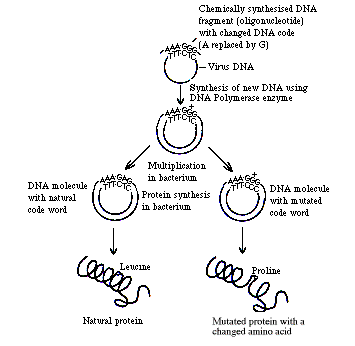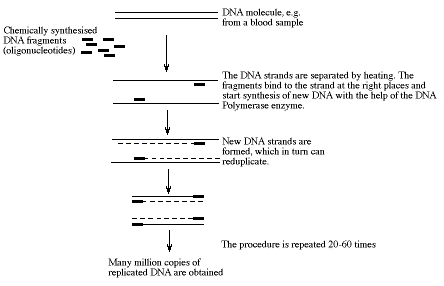Press release

13 October 1993
The Royal Swedish Academy of Sciences has decided to award the 1993 Nobel Prize in Chemistry for contributions to the development of methods within DNA-based chemistry,
with half to
Dr Kary B. Mullis, La Jolla, California, U.S.A., for his invention of the polymerase chain reaction (PCR) method,
and half to
Professor Michael Smith, University of British Columbia, Vancouver, Canada, for his fundamental contributions to the establishment of oligonucleotide-based, site-directed mutagenesis and its development for protein studies.
Decisive progress in gene technology through two new methods: the polymerase chain reaction (PCR) method and site-directed mutagenesis
The chemical methods that Kary B. Mullis and Michael Smith have each developed for studying the DNA molecules of genetic material have further hastened the rapid development of genetic engineering. The two methods have greatly stimulated basic biochemical research and opened the way for new applications in medicine and biotechnology.
The applications of Mullis’ PCR method are already many. It is for example possible using simple equipment to multiply a given DNA segment from a complicated genetic material millions of times in a few hours, which is of very great significance for biochemical and genetic research. The method offers new possibilities particularly in medical diagnostics, and is used, for example, for discovering HIV virus or faulty genes in hereditary diseases. Researchers can also produce DNA from animals that became extinct millions of years ago by using the PCR method on fossil material.
The genetic code programmed into the DNA molecule determines the number and sequence of amino acids in a protein, and thus also the functional properties of the protein. With Smith’s method it is possible to re-programme the genetic code and in this way replace specific amino acids in the proteins. This is termed site-directed mutagenesis. The possibilities of studying the structure and function of the protein molecules have changed fundamentally, and hence also the possibilities of constructing proteins with new properties. Attempts are being made, for example, to improve protein stability so that proteins can manage technical processes, to tailor antibodies so that they can attack cancer cells and to alter proteins to create faster-growing crop strains. The term protein design has already become a concept.
Background
Chemically, the genetic material of living organisms consists of DNA (deoxyribonucleic acid). DNA molecules consist of two very long strands twisted around each other to form a double helix. Each strand is formed of smaller molecules, nucleotides, that represent the letters of the genetic material. There are only four different letters, designated A, T, C and G. The two DNA strands are complementary, being held together by A – T and G – C bonds. It is only when the genetic code is to be read off e.g. for protein building in the cell that the two strands are separated. The genetic information in DNA exists as a long sentence of code words, each of which consists of 3 letters which can be combined in many different ways (e.g. CAG, ACT, GCC). Each three-letter code word can be translated by special components within the cell into one of the twenty amino acids that build up proteins. It is the proteins that are responsible for the functions of living cells, including their ability to function, among other things, as enzymes maintaining all the chemical reactions required for supporting life. The proteins’ three-dimensional structure and hence their function is determined by the order in which the various amino acids are linked together during protein synthesis.
Site-directed mutagenesis
The flow of genetic information goes from DNA via the translator molecule RNA to the proteins. By re-programming the code of a DNA molecule, e.g. changing the word CAC to GAC, it would be possible to obtain a protein in which the amino acid histidine is replaced by the amino acid aspartic acid. In nature, such mix-programming of the genetic material (mutation) occurs randomly, and is nearly always fatal to the organism. However, a dream of biochemical researchers has been to alter a given code word in a DNA molecule so as to be able to study how the properties of the mutated protein differ from the natural. It was through Smith’s oligonucleotide-based site-directed mutagenesis that this dream became reality. As early as the 1970s Smith learned to synthesize oligonucleotides, short, single-strand DNA fragments, chemically. He also studied how these synthetic fragments could bind a virus to DNA. Smith then discovered that even if one of the letters of the synthetic DNA fragment was incorrect it could still bind at the correct position in the virus DNA and be used when new DNA was being synthesized. At the beginning of the 1970s Smith was a visiting researcher at Cambridge and the story goes that it was during a coffee-break discussion that the idea arose of getting a reprogrammed synthetic oligonucleotide to bind to a DNA molecule and then having it replicate in a suitable host organism. This would give a mutation which in turn would be able to produce a modified protein. In 1978 Smith and his co-workers made this idea work in practice. They succeeded both in inducing a mutation in a bacteriophagic virus and “curing” a natural mutant of this virus so that it regained its natural properties. Four years later Smith and his colleagues were able for the first time to produce and isolate large quantities of a mutated enzyme in which a pre-determined amino acid had been exchanged for another one.

Smith’s method has created entirely new means of studying in detail how proteins function, what determines their three-dimensional structure and how they interact with other molecules inside the cell. Site-directed mutagenesis has without doubt revolutionised basic research and entirely changed researchers’ ways of performing their experiments. The method is also important in biotechnology, where the concept protein design has been introduced, meaning the construction of proteins with desirable properties. It is already possible, for example, to improve the stability of an enzyme which is an active component in detergents so that it can better resist the chemicals and high temperatures of washing water. Attempts are being made to produce biotechnically a mutated haemoglobin which may give us a new means of replacing blood. By mutating proteins in the immune system, researchers have come a long way towards constructing antibodies that can neutralise cancer cells. The future also holds possibilities of gene therapy, curing hereditary diseases by specifically correcting mutated code words in the genetic material. Site-directed mutagenesis of plant proteins is opening up the possibility of producing crops that can make more efficient use of atmospheric carbon dioxide during photosynthesis.
The “Polymerase Chain Reaction” (PCR)
The PCR technique was first presented as recently as 1985 but is nevertheless already one of the most widespread methods of analysing DNA. With PCR it is possible to replicate several million times, in a test tube, an individual DNA segment of a complicated genetic material. Mullis has described how he got the idea for the PCR during a night drive in the Californian mountains. Two short oligonucleotides are synthesized so that they are bound correctly to opposite strands of the DNA segment it is wished to replicate. At the points of contact an added enzyme (DNA polymerase) can start to read off the genetic code and link code words through which two new double strands of DNA are formed. The sample is then heated, which makes the strands separate so that they can be read off again. The procedure is then repeated time after time, doubling at each step the number of copies of the desired DNA segment. Through such repetitive cycles it is possible to obtain millions of copies of the desired DNA segment within a few hours. The procedure is very simple, requiring in theory only a test tube and some heat sources, even though there are now commercial PCR apparatuses that manage the whole procedure automatically and with great precision.
 |
| The PCR method can be used for reduplicating a segment of a DNA molecule, e.g. from a blood sample. The procedure is repeated 20-60 times, which can give millions of DNA copies in a few hours. |
As has site-directed mutagenesis, the PCR method has decisively improved the outlook for basic research. The sequencing and cloning of genes has been appreciably simplified. PCR has also made Smith’s method of site-directed mutagenesis more efficient. Since it is possible with PCR to perform analyses on extremely small amounts of material, it is easy to determine genetic and evolutionary connections between different species. It is very probable that PCR combined with DNA sequencing is going to represent a revolutionary new instrument for studies of the systematics of plant and animal species.
The biomedical applications of the PCR method are already legion. Now that it is possible to discover very small amounts of foreign DNA in an organism, viral and bacterial infections can be diagnosed without the time-consuming culture of microorganisms from patient samples. PCR is now being used, for example, to discover HIV infections. The method can also be exploited to localise the genetic alterations underlying hereditary diseases. Thus PCR, like site-directed mutagenesis, has a great potential within gene therapy. Without the PCR method, the HUGO project, with its objective of determining every single DNA code in, among other things, the human genetic material, would hardly be realistic. In police investigations PCR can give decisive information since it is now possible to analyse the DNA in a single drop of blood or in a hair found at the scene of a crime.
Another fantastic application is that it is possible to mass-produce DNA from fossil remains. Researchers have, for example, succeeded in producing genetic material from insects that have been extinct for more than 20 million years by using the PCR method on DNA extracted from amber. This possibility has already inspired authors of science fiction. The very popular film “Jurassic Park” is about the fear that arises when researchers using PCR recreate extinct giant reptiles.
Nobel Prizes and laureates
Six prizes were awarded for achievements that have conferred the greatest benefit to humankind. The 14 laureates' work and discoveries range from quantum tunnelling to promoting democratic rights.
See them all presented here.
